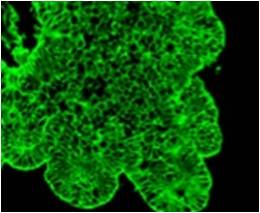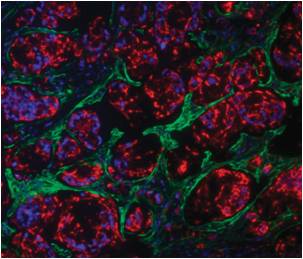A recent paper shows Sir Walter Bodmer’s Anti-EpCAM, clone AUA1 used in flow cytometry analysis. This study, carried out at Hosiptal S. Francisco Xavier in Lisbon, concluded that detection of EpCAM positive cells using flow cytometry in lymph node biopsies, bone marrow aspirates and cerebrospinal fluid is strongly indicative of the presence of carcinoma cells.

AUA1 stained SW1222 cells. Image published in Yeung et al. 2010. Proc Natl Acad Sci U S A. 107(8):3722-7.
AUA1 recognises the Epithelial Cell Adhesion Molecule (EpCAM) and is therefore a good tool to use for the characterisation of all epithelial cells. A graduate student in Bodmer’s lab, James Arklie created this antibody through the immunisation of BALB/c mice with the colon-carcinoma cell line LoVo. At the time the target was yet to be identified as EpCAM and the clone was therefore named Arklie’s Unknown Antigen 1 – AUA1.
Bodmer’s lab has extensively published upon this antibody. A particularly interesting paper, published in 2013, showed that epithelial cells were only present in lymph nodes that harboured metastases.

Myofibroblasts are intimately associated with CRC lymph node metastases. Costaining of paraffin-embedded sections of lymph nodes with alphaSMA (green) for myofibroblasts and AUA1 (red) to identify epithelial cells. Image published in Yeung et al. 2013. Br J Cancer. 108(10):2106-15
Sir Walter Bodmer is currently Head of the Cancer and Immunogenetics Laboratory at the University of Oxford. He first became interested in genetics through a final year mathematics module taught by Sir Ronald Fisher at the University of Cambridge. Subsequently his contributions to the genetics field have been invaluable and as a result he was knighted in 1986.
View the datasheet for more information and publications.
HAVE YOU REGISTERED?
Join the ever-growing global Ximbio community. Register and receive updates about new reagents, institutes and new features being added to the website.
